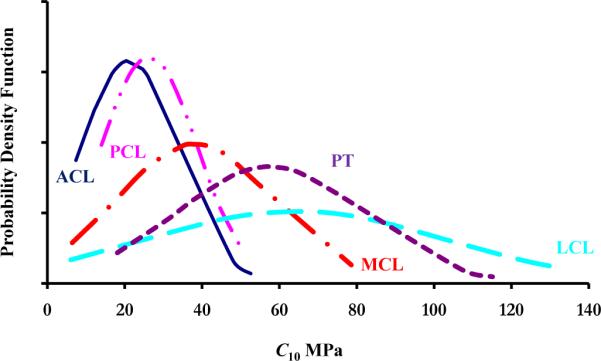Figure 2.

Based on experimental data, the figure shows the probability density function of the neo-Hookean coefficient (C10) of the ACL (Butler et al., 1992; Butler et al., 1986; Chandrashekar et al., 2005; Hagena et al., 1989; Jones et al., 1995; Marinozzi et al., 1983; Mommersteeg et al., 1995; Noyes et al., 1984; Noyes and Grood, 1976; Trent et al., 1976; Woo et al., 1991), PCL (Butler et al., 1986; Hagena et al., 1989; Marinozzi et al., 1983; Mommersteeg et al., 1995; Moon et al., 2006; Prietto et al., 1988; Race and Amis, 1992; Race and Amis, 1994; Trent et al., 1976), MCL (Bonifasi-Lista et al., 2005; Bull, 1998; Claes et al., 1987; Marinozzi et al., 1983; Mommersteeg et al., 1995; Quapp and Weiss, 1998; Robinson et al., 2005; Trent et al., 1976), LCL (Butler et al., 1986; Ciccone et al., 2006; Claes et al., 1987; Espregueira and Vieira da Silva, 2006; LaPrade et al., 2005; Marinozzi et al., 1983; Maynard et al., 1996; Meister et al., 2000; Mommersteeg et al., 1995; Sugita and Amis, 2001; Trent et al., 1976), andPT (Blevins et al., 1994; Butler et al., 1986; Cooper et al., 1993; Flahiff et al., 1995; Haraldsson et al., 2005; Hashemi et al., 2005; Haut and Powlison, 1990; Johnson et al., 1994; Noyes et al., 1984; Paulos et al., 1988; Staubli et al., 1999; Wilson et al., 1999). In this study, it was assumed that the range of the MPL and LPL was similar to those reported for the MCL and LCL, respectively. The strain energy function used to describe the neo-Hookean model was given in the form C10(I1 – 3).
